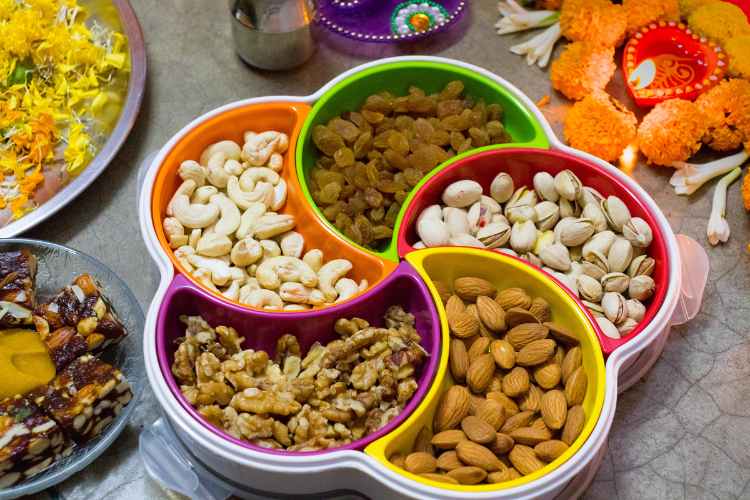For people with diabetes, managing food choices is essential. By including the correct meals, like dry fruits, you can get all the nutrients you need without raising your blood sugar levels. In this comprehensive guide, we will explore a curated list of dry fruits for diabetics to eat. These fruits are excellent for preserving stable blood sugar levels since they are high in fiber, good fats, and antioxidants. We will go into detail about the nutritional advantages of each dry fruit, emphasizing its glycemic index and suggested serving sizes. Moreover, if you are looking for a list of dry fruits for diabetics to eat in Hindi then we have also mentioned the name of each dry fruit in Hindi.
People with diabetes can make educated decisions to promote their overall health by studying how these dry fruits affect blood sugar and how to include them in a balanced diet. So read the article till the end to know the complete list of dry fruits for diabetics to eat.
List of Dry Fruits for Diabetic People
Here is the list of dry fruits for diabetics to eat as mentioned below:
1. Apricots or Khumani
Low GI foods like dried apricots have a score of 30 to 32. They also contain 4.7 grams of fiber and 2.2 grams of protein. In addition to providing important minerals like vitamin A, iron, potassium, and calcium, this tart-tasting dried fruit also does so. Diabetes sufferers should stay away from canned, dried apricots with syrup.
2. Dates or Khajoor
Tropical dates are available in both dry and moist kinds. Due to their high content of nutritional fiber, dry dates help you feel fuller for longer and reduce your appetite. Additionally, diabetics with anemia should consume this delicious and iron-rich dried fruit.
Despite their sweetness, dates, depending on the type, have a low to moderate glycemic index (GI). According to a study, the five widely consumed date varieties—Fara’d, Lulu, Bo Ma’an, Dabbas, and Khalas—have low GIs. As a result, diabetics can consume dates in moderation.
3. Raisins or Kishmish
There are 2.2 grams of protein and 2.7 grams of fiber in a half cup of raisins. Additionally, raisins have a GI score between 54 and 66, making them low to medium GI dried fruit. Anemia and constipation can both be treated with raisins.
4. Prunes or Sookha Aloo Bukhara
Prunes are dried plums that contain almost 6.2 grams of fiber per half-cup dose. Prunes are excellent for overweight or obese diabetics since they have a low GI of 29 and high fiber content.
5. Almonds or Badam
Although they are frequently referred to as nuts, almonds are actually a sort of dry fruit. However, because they have a GI score that is nearly zero, soaked almonds are a fantastic diabetes-friendly alternative. They are excellent for both adults and children since they are rich in vitamin E and antioxidants.
6. Figs or Anjeer
Depending on the variety, dried figs have 19–26g of sugar and 4g of fiber per serving. Figs shouldn’t spike blood sugar as quickly as foods with a high glycemic index because of their low to moderate GI. Additionally, combining it with walnuts and plain Greek yogurt will minimize its GI impact.
7. Walnuts or Akhrot
You should consider including walnuts in your regular diet. To improve its flavor and texture, use it with your salads and yogurt. They are abundant in fiber, antioxidants, and omega-3 fatty acids.
According to several studies, incorporating walnuts into a diabetic person’s diet may improve blood sugar control and lower their chance of developing cardiovascular illnesses.
8. Pistachios or Pisata
Pistachios are a powerhouse of antioxidants, fiber, healthy fats, and protein. 15.36 g (2 tablespoons) of pistachios contain approximately 1.6 g of fiber and 3 g of protein per serving. According to research, pistachios can help type 2 diabetics maintain better glycemic control and lessen inflammation and insulin resistance.
Benefits of Eating Dry Fruits for Diabetic People
Dry fruits have a better nutritional value and a higher concentration of minerals and vitamins due to their sun-dried nature. Additionally, this list of dry fruits for diabetics to eat have a naturally sweet flavor so diabetes patients’ sweet desires could be readily subdued.
This dry fruits list for diabetics offers several benefits like –
- Rich in antioxidants, unsaturated fatty acids, dietary fiber, protein, vitamins, and minerals.
- They have a wonderful flavor and help diabetes people by acting as a natural sweetener.
- Dry fruits are a good midday snack option for those with diabetes.
- For diabetics, low- or medium-glycemic-index dry fruits are preferable.
- Omega-3 and Omega-6 fatty acids are found in abundance in many nuts and dry fruits, and they support a healthy heart and digestive system.
- It offers a tasty and healthy snack alternative while assisting with body weight control.
- It helps to reduce inflammation brought on by illness and blood sugar levels.
- The dry fruit most frequently recommended for diabetes is almonds. They aid to provide cholesterol-free radicals and reduce the food’s glycemic index when consumed after meals.

FAQs
Are dry fruits safe for people with diabetes?
Ans. Many people usually query about can diabetes patients eat dry fruits so yes dry fruits are safe for people with diabetes. They include a lot of fiber, minerals, vitamins, and antioxidants. Furthermore, most dry fruits have a low to medium GI rating. This makes dry fruits more suitable for those with diabetes.
What makes dry fruits a good option for diabetics?
Ans. As opposed to many sweet snacks, dry fruits have a lower glycemic index, making them an excellent choice for diabetics. They offer fiber, minerals, and natural sugars that can help control blood sugar levels.
Which dry fruits have a low glycemic index (GI)?
Ans. According to a recent study, dried fruits including dates, raisins, apricots, and sultanas can be a healthy addition to a diabetic person’s diet because they have a low glycemic index.
Which dry fruits should I avoid?
Ans. Any dry fruit with high sugar content, such as raisins, dates, figs, etc., would be bad because they instantly raise blood sugar levels.
How much should I eat in a day?
Ans. If you are wondering how much dried fruit can a diabetic eat then you should know that the recommended daily intake of dry fruits for diabetics can change depending on their nutritional requirements, degree of exercise, and general dietary habits. Typically, a modest handful of mixed dry fruits—about 1 ounce or 28 grams—can be considered a good serving size.
RELATED – HOW MANY CALORIES DOES 20 BURPEES BURN?: KNOW IN DETAIL ABOUT BURPEES
Conclusion
In conclusion, a variety of flavors and nutrients can be incorporated into a diabetes-friendly diet by choosing from this list of dry fruits for diabetics to eat. These healthy snacks can support a well-rounded strategy for treating diabetes because of their low glycemic index and capacity to control blood sugar. Portion control is still essential, though, as even these healthful foods can raise blood sugar levels if consumed in excess. It is suggested that you speak with a dietitian or healthcare provider before making any significant dietary adjustments. We hope you found this article informative and now you know the complete list of dry fruits for diabetics to eat that you were looking for.

